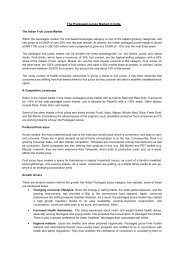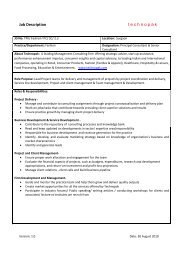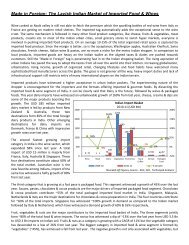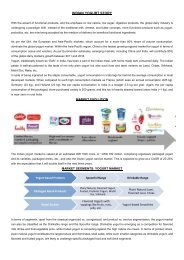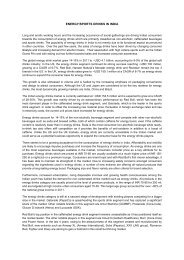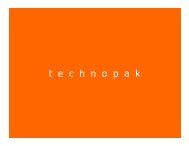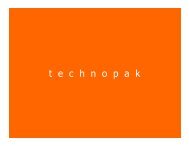a quarterly report by - Technopak
a quarterly report by - Technopak
a quarterly report by - Technopak
You also want an ePaper? Increase the reach of your titles
YUMPU automatically turns print PDFs into web optimized ePapers that Google loves.
perspective<br />
a quar terly repor t <strong>by</strong><br />
The single largest category is woven apparel followed <strong>by</strong> knitted apparel, made-ups and cotton based<br />
textiles.<br />
Growth Prospects<br />
India’s current domestic consumption of US$<br />
40 Bn is expected to grow to ~US$ 200 Bn over<br />
the next 25 years (growing at over 7% per year).<br />
India’s exports are expected to grow to ~US$ 125<br />
Bn from the current level of US$ 22 Bn <strong>by</strong> 2035.<br />
Volume 02 / 2009<br />
Exhibit 2<br />
Investment in Textile and Apparel Manufacturing<br />
Sector Investment Required (US$ Mn)<br />
1. Spinning 55,000<br />
2. Weaving 25,000<br />
3. Knitting 10,000<br />
| Volume 02<br />
However, the visible bottleneck to the above 4. Fabric Processing 40,000<br />
growth is the shortfall in the supply to meet 5. Home textiles 4,200<br />
the aforementioned demand. The current<br />
manufacturing capacities cannot meet the unprecedented growth in the demand and therefore, we<br />
would need mega investments to the tune of US$ 130 - 135 Bn over next 25 years in textile and apparel<br />
manufacturing.<br />
If the required demand is not met <strong>by</strong> indigenous manufacturing then it would be met <strong>by</strong> imports from Asian<br />
countries like China, Bangladesh, Vietnam, Korea etc.; Eastern European countries like Romania, Bulgaria,<br />
Tunisia etc.; and African countries like Kenya, Nigeria, Egypt etc.<br />
One of the biggest questions to be answered here is - who will invest? We firmly believe that FDI can act as<br />
a catalyst to trigger this investment. One of the most commonly known benefits of FDI is the “Crowding-in”<br />
effect. With entry of foreign firms in the sector, the confidence level of investing in the sector increases and<br />
it has been usually seen that more and more domestic manufacturers follow suite.<br />
Considering the above logic, we believe that approximately 75% to 80% of the investment would still be<br />
done <strong>by</strong> the domestic business houses, but the balance 20% to 25% investment required as FDI will give<br />
the required confidence to invest in the sector.<br />
A prime example of the same would be what US auto sector underwent in the 1980s.<br />
•Companies<br />
invest in the US because it is single largest economy in the world and its labor pool is one<br />
of the best educated, most productive and innovative, and it provides world class infrastructure.<br />
•The<br />
US auto sector in the 1980s had several features that made it an attractive setting for FDI. Both<br />
the end-product automobile sector, where there were only ‘The Big Three’ US assemblers (General<br />
Motors, Ford, and Chrysler), and the large number of firms in the auto component supply sector<br />
provided such an opportunity.<br />
•There<br />
was substantial inward FDI that originated predominantly from a single country, Japan. This<br />
investment likely increased the competition that then led to productivity changes. In addition, the<br />
Japanese entrants possessed superior production techniques and management practices, which<br />
created the potential for technology transfer.<br />
•They<br />
began to produce vehicles in North America and began to purchase inputs from US autocomponent<br />
manufacturers.<br />
•The<br />
results suggest that increased competitive pressure in the auto sector was the main cause of<br />
overall productivity improvement, at least during the initial stages of foreign direct investment of<br />
the 1980s.<br />
FDI : A Catalyst for Growth of the Textile & Apparel Industry |<br />
32



